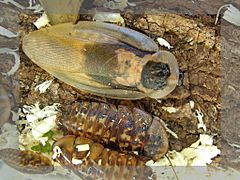Exopterygota facts for kids
Quick facts for kids ExopterygotaTemporal range: Carboniferous–Recent
|
|
|---|---|
 |
|
| Death's head cockroach Adult (above) and two immatures |
|
| Scientific classification | |
| Kingdom: | |
| Phylum: | |
| Subphylum: | |
| Class: | |
| Subclass: | |
| Infraclass: | |
| Superorder: |
Exopterygota
|
| Orders | |
|
Caloneurodea (Extinct) For orders previously in the Exopterygota, see Dictyoptera and Parapneuroptera. |
|
The Exopterygota are a large group of insects. They are part of the Pterygota subclass. This means they are insects that have wings.
Exopterygota are also called "externally winged forms." This name describes how their wings grow. Their young look a lot like the adults.
What Are Exopterygota?
Exopterygota is a "superorder" of insects. A superorder is a big group that contains several smaller orders. This group includes many common insects.
Some examples are locusts, thrips, and lice. There are eight main orders within the Exopterygota group.
How Do They Grow?
The way Exopterygota insects grow is quite special. Their young are called nymphs. These nymphs look very similar to the adult insects.
The wings of Exopterygota grow on the outside of their bodies. They do not go through a pupal stage. This is different from insects like butterflies.
Nymphs grow into adults by shedding their skin several times. Each time they shed, they get a little bigger. They also look more like the adult insect. This process is a gradual change.
Exopterygota vs. Endopterygota
Insects are divided into two main groups based on how their wings develop. These are Exopterygota and Endopterygota. The Endopterygota are also known as Holometabola.
Endopterygota means "internal winged forms." These insects grow their wings inside their bodies. They also go through a complete change, called metamorphosis. This includes a pupal stage, like a cocoon.
Exopterygota, as mentioned, are "external winged forms." Their wings grow on the outside. They do not have a true pupal stage. This is the main difference between these two large insect groups.
See also
 In Spanish: Exopterygota para niños
In Spanish: Exopterygota para niños

